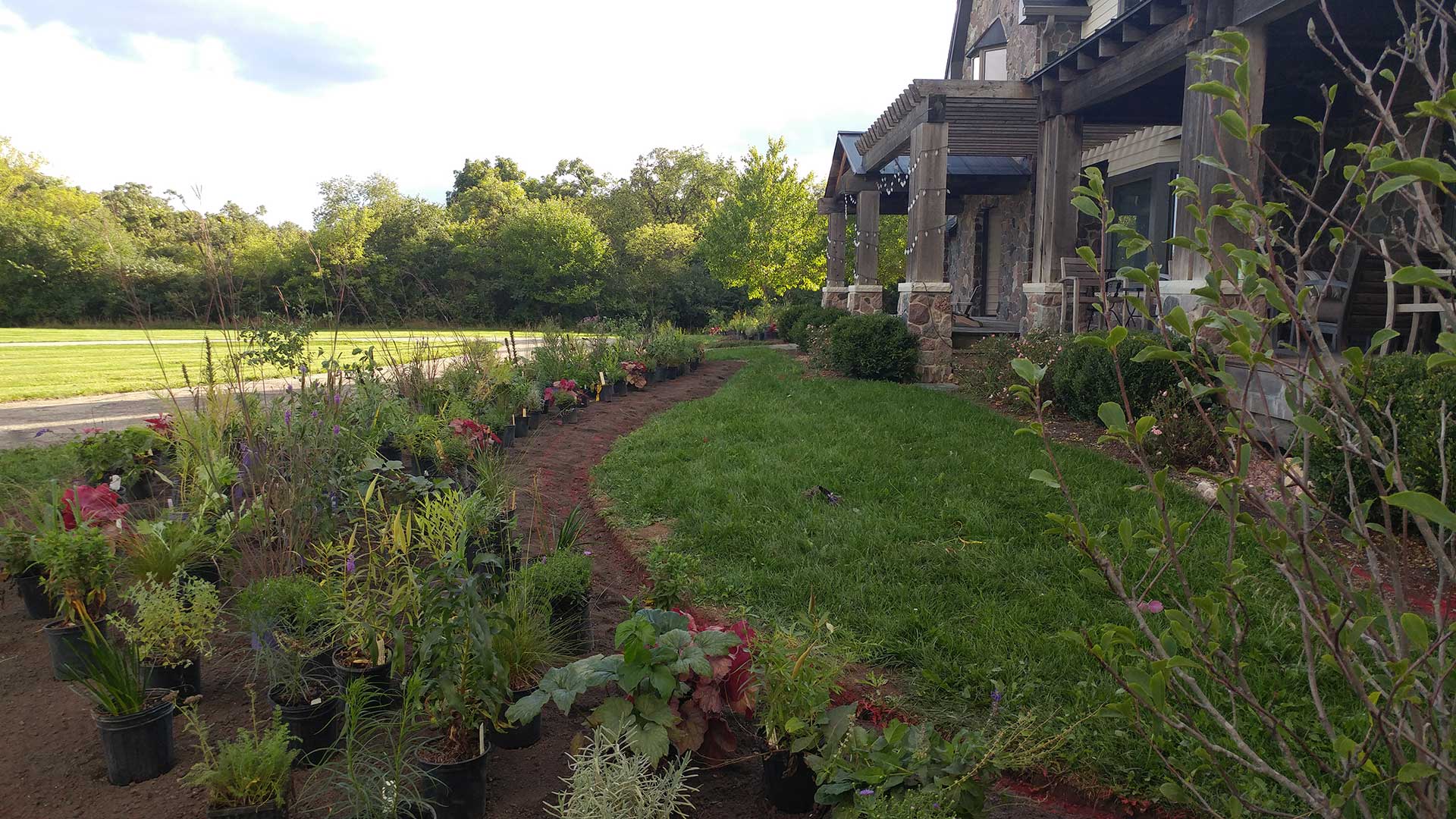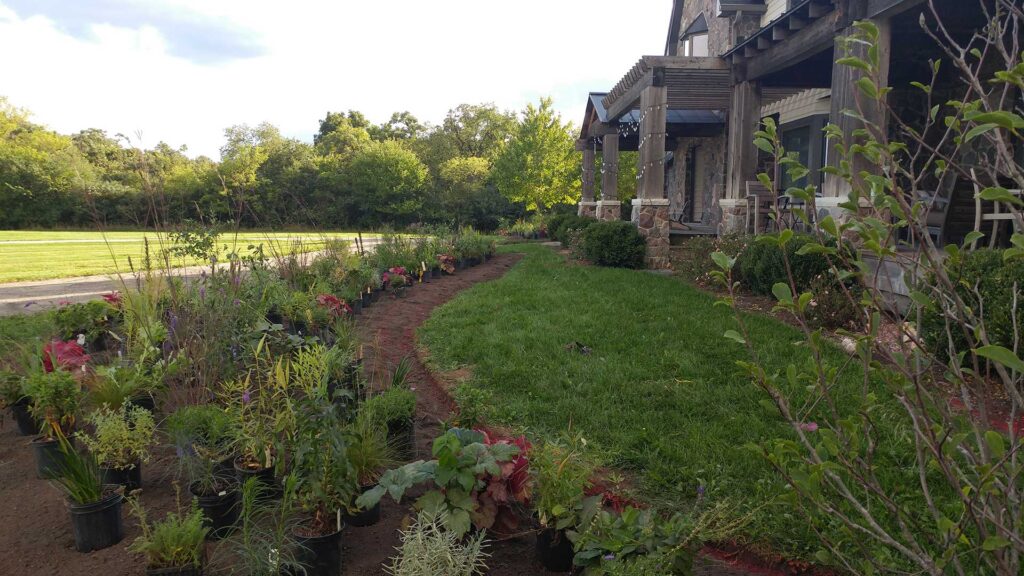Landscape borders define space and delineate real and/or representational boundaries. Borders can invite or they can deter. They can be practical or just plain fun. A border may be a short, single line of plants or it may be a wide, long, diverse collection of trees, shrubs, perennials, annuals, flowers, and vegetables. To some gardeners, borders are a medium for expression of balance between the horticultural and the man-made environments – homes, outdoor living space, and areas of community interaction. To others, borders are another great opportunity to plant more stuff. Whatever the reasoning, a border should have balanced proportions, possess thoughtful color flow, and offer plenty of textural interest. And whether the style is formal, informal, or naturalistic, the work involved in successful “bordering” can be quite intensive, belying the offhand appearance.
Historically, formal garden borders have been fixtures within civilizations for thousands of years – documentation first places them between 4000 and 3000 B.C. In western cultures, early formal borders were used to define space, provide food, and mimic architectural forms. The size and contents of formal border gardens followed, and changed with, fashionable architectural and landscape design tenets. In large estate gardens, formally structured borders were important in providing an exterior aesthetic visually complimenting the affluent lifestyle. They provided the physical delineation for exterior rooms of respite enjoyed by the household and guests. As a bonus within this often large and formally laid out plan, border plant material was chosen and planted to provide additional food in the form of fruits, nuts, and vegetables for the dining tables. For the average household garden, formally structured borders functioned primarily as a production area that provided a large percentage of the household’s yearly food supply. As it was important to provide a reliable water supply throughout the growing season, irrigation systems were frequently employed. Those early irrigation systems, which by design and limited flow capacity, had to run in straight lines – as did the borders relying on them. As irrigation systems developed, changes in design allowed for higher capacity water provision and curved or circular delivery systems. The formal border went from strict linear to flowing forms, making the formal border about style and clean lines.
Orderly repetition – simple or complex in plant material – and tidily controlled appearance is key in successfully achieving a formal look. Daily attention and regular maintenance are key to successfully keeping it. Plant materials for formal borders should provide balance in scale to the landscape from planting to maturity. Materials used should be those that either keep a rather regimented form on their own (breeding tells here) or those that respond well to repeated trimmings. Before choosing any plant for border hedging, be sure to look at mature height. If trying to fool nature and keep a 60-foot (eventual mature height) tree to 12 feet, you will not like the results in 10 to 15 years. Trunks will become unseemly, interior foliage dies out, and just about the time the shape and form develop to plan, it will need to be replaced. Although a tenacious gardener can prune most plants to a stature smaller than what nature intended, using dwarf varieties for a lower height border is a better idea. Choosing whether to use evergreens or deciduous plants for a formal border is a personal design choice. Both can offer the appropriate structure needed to convey that orderly repetition necessary for the sense of formality. Buxus (boxwood), Juniperus (juniper), Taxus (yew), and Thuja (arborvitae) have long been evergreen staples for hedging and border use for good reason. They are consistent performers when appropriately chosen and placed. Some evergreens that are not often thought of for formal border hedging – but should be – are Chamaecyparis (falsecypress), Ilex (holly), and Tsuga canandensis (hemlock).
If the border style and design do not call for evergreens, there are many deciduous plants that respond beautifully to the structuring needed to successfully create a border – Acanthopanax sieboldianus (fiveleaf aralia), Caragana (Russian peashrub), Carpinus caroliniana (American hornbeam), Cotoneaster, Fagus (beech), Physocarpus (ninebark), Rhodotypos scandens (black jetbead), Ribes alpinum (alpine currant), Rosa (rose), Salix (willow), Spiraea (spirea), Viburnum dentatum (arrowwood), Viburnum lentago (nannyberry), and Viburnum prunifolium (blackhaw). As always, look for those that are cold hardy and/or heat tolerant and fit your landscape and environmental requirements. Be aware that many deciduous plants that are good for hedging can also be invasive – that is what makes them good, responsive growers when repeatedly trimmed. Choose wisely.
To keep the formal borders looking full and well-kept, filler plants need to provide a solid performance throughout the season. With most perennials, that will mean careful planning to achieve flow and continuity in flower and foliage interest. Consider incorporating annuals to heighten season-long appeal and reinforce the overall appearance. Annuals providing beautiful foliage and that hold well throughout most summer conditions include Alocasia (elephant ear), Alternanthera (calico plant), Begonia rex-cultorum, Caladium, Cannas (canna lily), Colocasia (taro), Plectranthus, Setcreasea pallida (purple heart), Strobilanthes dyerianus (Persian shield), and Zea mays (ornamental corn – variegated selections are beautiful). Traditional annuals that should never be overlooked are wax or tuberous Begonias, Calendula (marigold), Celosia (cockscomb), Cerinthe (honeywort), Dahlias, Datura (thorn apple or horn of plenty – poisonous, use with care), Heliotropium (heliotrope) for scent and color, Hibiscus, Lobelia, Lobularia (alyssum), Pelargonium (geranium), Petunia, Tagetes tenuifolia (especially the ‘Gem’ series of marigolds), Torenia (wishbone flower) that performs best early to mid-season, Turnera ‘Eldorado’ (buttercup flower), Verbena (vervain), and Zinnia.
Shrub or shrubby-like plants that fill well at higher heights are Abelia (available for many zones), Caryopteris (blue mist spirea), Deutzia, (Exocorda (Pearl Bush), Hamamelis (witch-hazel), Heptacodium (Seven Sons Flower), Rhododendron – Northern Light series, Syringa (lilac), and Tibouchina grandiflora, which has outstanding leaf form in addition to great flowers.
Do not forget the beauty and function that herbs can add to even the most formal of plantings. Herbs responding well to repeated trims are basil, leaf lettuce, and parsley. The many herbs providing good interest and age well through the season include bay, chamomile, chives, kale, lavender, ornamental peppers, rosemary, sage, and thyme.
For a more modernistic take on a formal garden, ornamental grasses project consistent clean lines with interesting movement and can provide excellent impact. Try Hakonechloa (Japanese forest grass), Carex, Calamagrostis (small reed), Panicum virgatum (millet), Spodiopogon sibiricus, Sporobolus heterolepsis, and Eragrostis (love grass) to name just a handful.
If symmetrical repetition, perfection, and architectural mimicry through plants is not desired in a border design, consider informal borders as an option. The informal style was made famous by Gertrude Jekyll’s artistic approach to gardening early in the 20th century. Now commonly employed in Western gardens around the world, the informal border is a romantic, modified fusion of formal and naturalistic styles. It employs the artistic skills necessary to carefully choose plant materials for color, light, and balance for design appeal over time, one season on to infinity. The casual appearance is the result of an intense study of environment, investigation into plant properties, and manipulation of color and balance. Prior to Jekyll’s influence, borders were often a more structured place to mainly showcase a collection of preferred or specific plants rather than an artistic medium to showcase garden color and form.
There is no set plant list for the informal border – the focus is on knowledge, patience, and of course, implementation. Almost anything can be included, or excluded, as is the preference of the gardener (or landowner) – trees, shrubs, perennials, annuals, herbs, and tropical plants are all fair game. Knowing plant properties provides the basis for placement to optimize the best features of each while simultaneously hiding those less desirous qualities. This knowledge, when implemented with that artistic flair, produces a glorious show throughout the season, and life, of the border. Patience is needed to know when to augment immature plantings and when to sit back and wait. The list of potential perennials is limited only by imagination. Try Achillea (yarrow), Adiantum (maidenhair fern), Allium, Amsonia (blue star flower), Anemone (windflower), Antennaria (pussy toes), Camassia (Quamash), Aquilegia (columbine), Arisaema (jack-in-the-pulpit), Ascelpias (milkweed), Aster, Astrantia (masterwort), Baptisia (false indigo), Boltonia, Campanula (bellflower), Clematis (many shrubby forms as well as climbers), Chleone (turtlehead), Coreopsis (tickseed), Delphinium, Dicentra (bleeding heart), Digitalis (foxglove), Dodecatheon (shooting star), Echinacea (coneflower), Echinops (globe thistle), Eupatorium (Joe Pye weed), Gaura, Gentian, Geranium, Gillenia (Indian physic), Helenium (sneezeweed), Helianthus (sunflower), Helleborus (false rose), Iris, Liatris (blazing star), Ligularia, Lilium, Lupinus (lupines), Lychnis (campion), Mertensia (bluebell), Monarda (bee balm), Nepeta (catnip), Paeonia (peonies – herbaceous and tree form), Perovskia (Russian sage), Phlox, Platycodon (balloonflower), Polemonium (Jacob’s ladder), Polygonatum (Solomon’s seal), Rudbeckia, Ruellia (fringed petunia), Salvia, Sanguisorba (burnet), Solidago (goldenrod), Stokesia (aster), Symphytum (comfrey), Tricyrtis (toad lily), Trillium, and/or Veronica (speedwell).
If formal or informal borders are not your style or do not quite fit into the style of architecture or landscape design desired, look at naturalistic. Throughout Eastern culture history, naturalistic gardening has been regarded, not as gardening, but as a form of higher art. Once only for mighty rulers or the very wealthy, the art of naturalistic gardening is now much embraced by all. Styled to imitate the ordered harmony of nature, the goal is to interpret nature without giving evidence of any intrusive human presence. Each garden border or space, no matter the size, employs simplicity, harmony, balance, tranquility, and above all, restraint – invisibly connecting and engaging the visitor in quiet interaction with the environment. The idea of “borrowing the landscape” (the seamless movement of the immediate landscape into the natural surrounds) is integral to blurring the lines between man’s interjection into nature and nature itself. Architectural elements, water, stone, and plants are all equally important components to consider, and all have substantial metaphorical meaning in the interpretation and reproduction of nature’s harmonious blending of opposites. Naturalistic borders and gardens are intricately simple, with many twists and turns revealing careful placement of elements, manipulating vistas to give the appearance of infinity. Frequently incorporated into the plantings is a square within a circle, representing the belief of earth within the heavens. Symbolic plant materials in Eastern culture naturalistic design include: Azalea and Rhododrendron (elegance and wealth), Bamboo (representing strength, resiliency, grace, simplicity, purity, and humility), Chrysanthemum (strong life, splendor, and courage), Magnolia (wealth), Paeonia (wealth and social status), Pinus sylvestris (Scotch Pine – symbolizing longevity and the struggle for survival), Prunus mume (flowering plum – symbolizes beginning), and Syringa (lilac – modesty). Restraint is important – think minimal usage for maximum impact. One of the leading designers in today’s world of Naturalistic design is Piet Oudolf of the Netherlands. His designs evoke a harmonious ebb and flow of natural materials set within the confines of a manmade world. Year-round design attention to changing color, form, and texture has been reawakened, worldwide, through his eyes.
Choosing a particular style or developing your own individual border design style is not only fun, but a good way to showcase garden knowledge and an even better place to try to expand it. No matter the choice in approach to border gardening, consider allowing at least 10 feet of width when incorporating any trees or shrubs to accommodate growth. If the border width is greater than four to six feet, reaching all plants from the front may be damaging to the plants as well as physically difficult. Leave space for human movement behind the border planting to safely access and care for all plant material.

